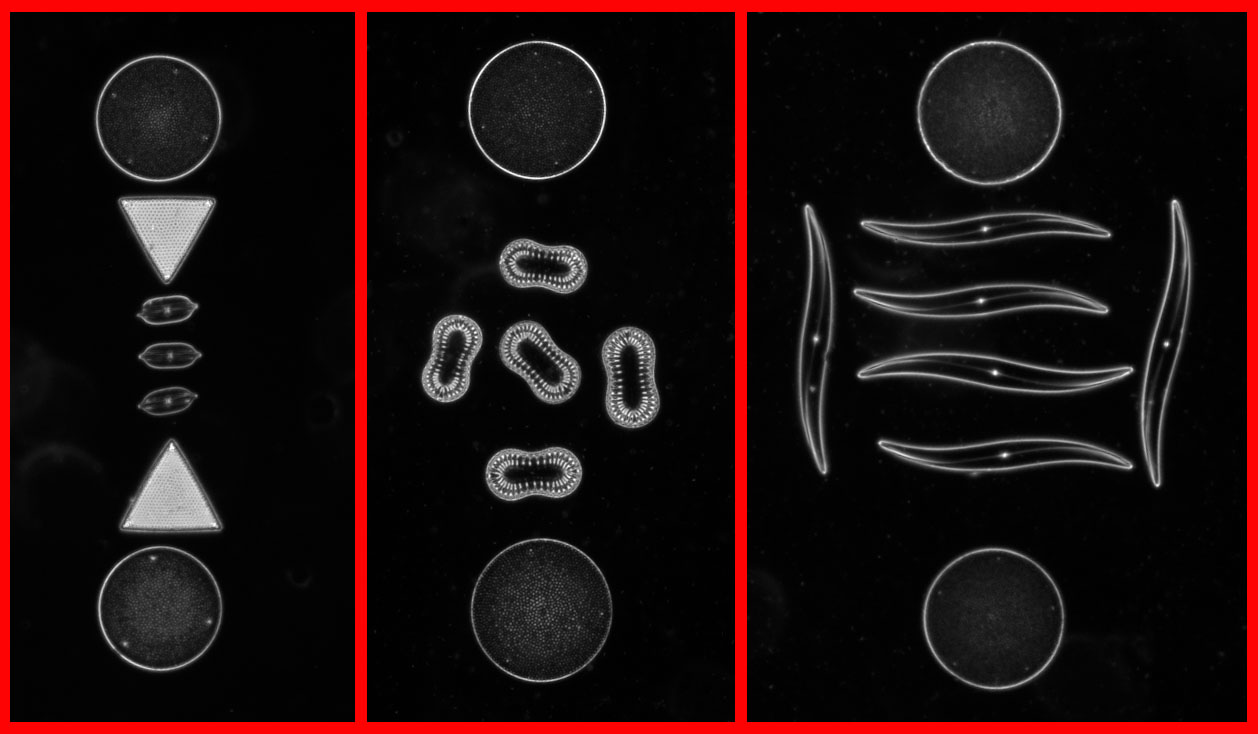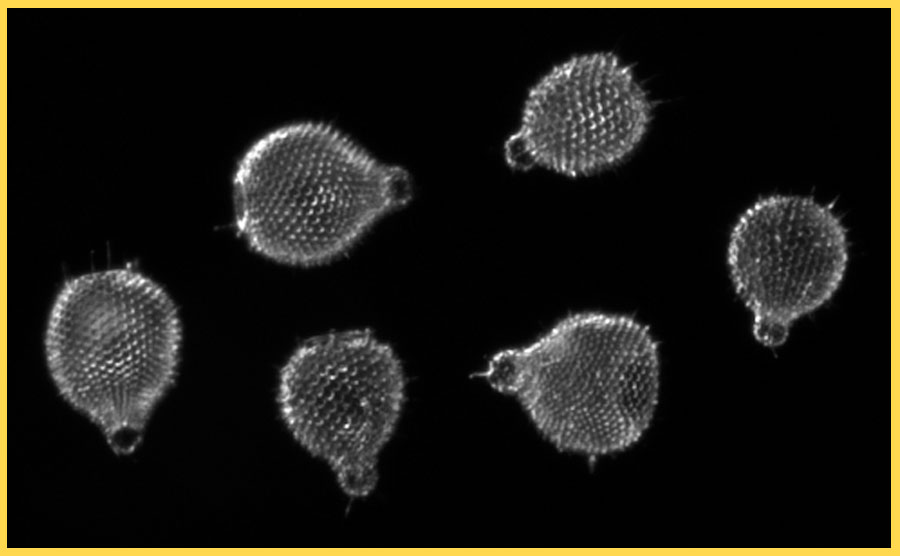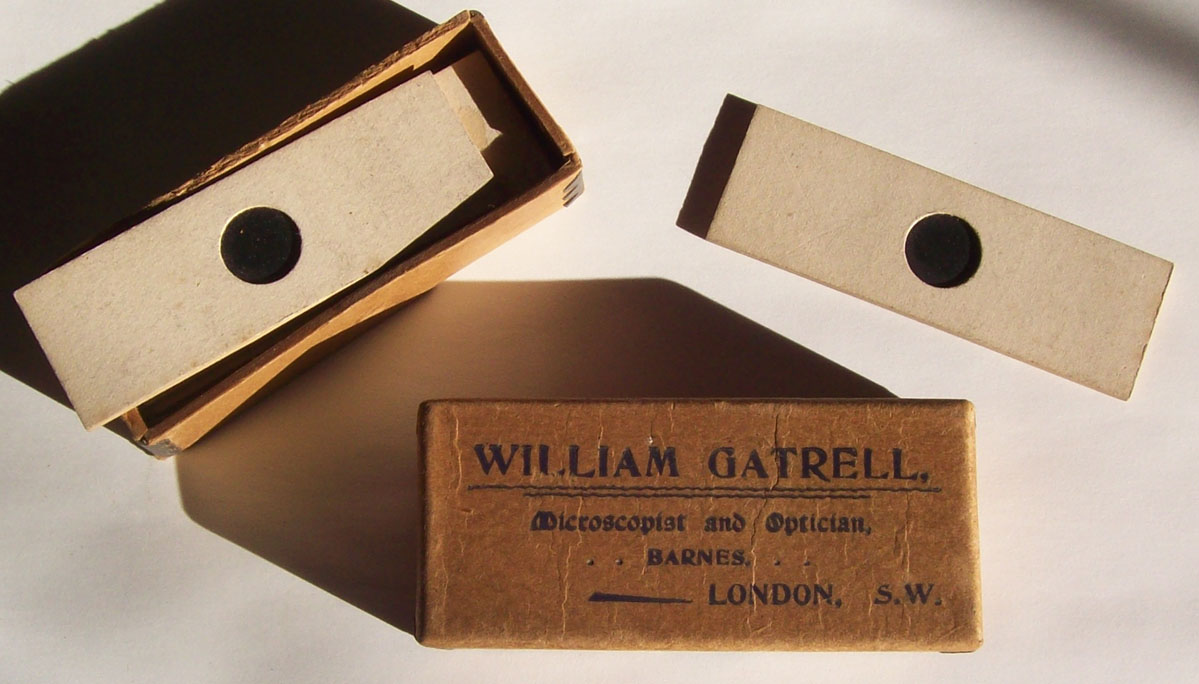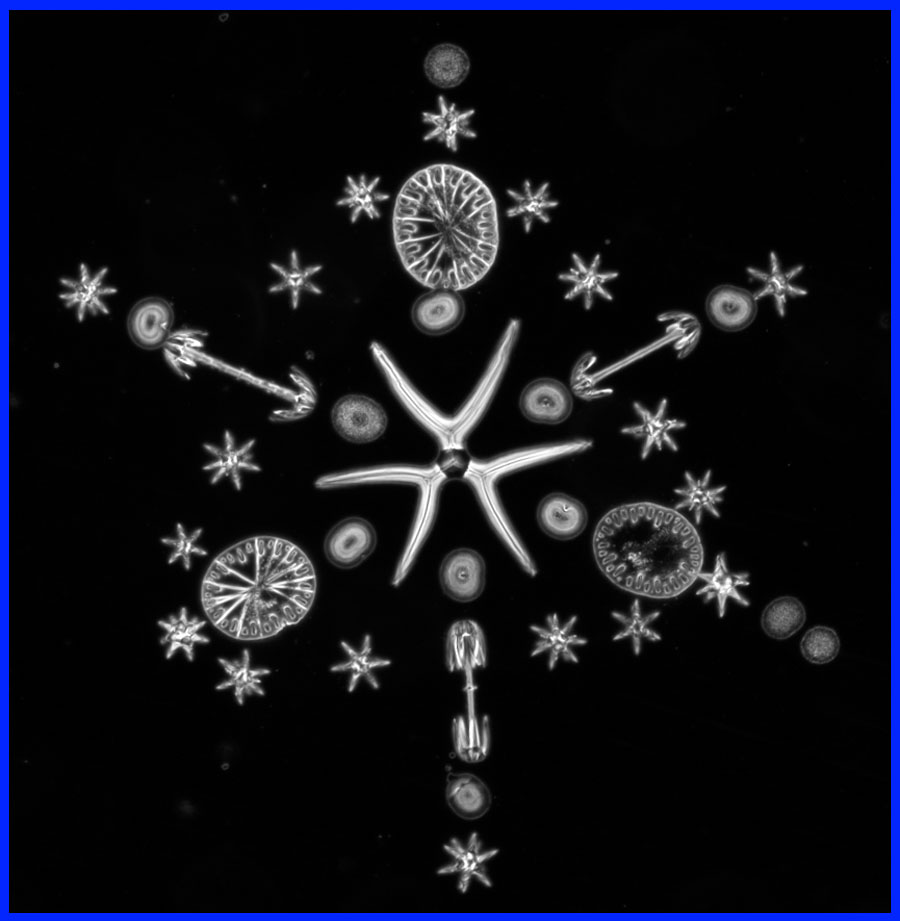
|
William Gatrell (1864-1902), Victorian Era Microscope Specimen Mounter by Brian Stevenson, Lexington, Kentucky, USA |
William Gatrell was highly regarded as a preparer of diatom microscope slides even during his short career. Edmund Spitta, in the 1899 book Photo-micrography, stated “We know of no mounter of diatoms in the United Kingdom that can surpass Mr. Firth, of Clifton Park Avenue, Belfast, and few that can equal him, save Mr. Gatrell, of Barnes, whose work is of the most excellent quality” (pages 129-130), “Mr. Gatrell has sent us some amphipleura pellucida mounted in realgar and other diatoms in quinidine and piperidine which are of the highest order of merit, especially the amphipleura pellucida, which of late have been so difficult to obtain” (page 130), and “Amphipleura pellucida…None that the writer has ever seen can compare with those prepared in realgar by Dr. Van Heurck, excepting those mounted by Mr. Gatrell” (page 140).
Three examples of Gatrell’s diatom slides are illustrated in Figure 1. In all the examples of single-species slides I have seen, he mounted a half dozen or so specimens between at least one pair of larger diatoms. The larger diatoms are visible even without a microscope, and serve as guides for centering the specimens prior to viewing. This style was also used by other mounters, such as Eduard Thum.

Figure 1. Three single-species diatom slides by William Gatrell. Left to right, specimens are labeled by Gatrell as Navicula approximata Greville, Surirella lata Wm. S., and Rhoicosigma robusta v. niflexa H. Pen. Images were rotated 90 degrees to make the figure. Photographed using an Olympus BX51 microscope, 4x objective lens, phase contrast illumination and a Retiga 2000R Fast 1394 with QCapture Pro software.
Gatrell used pale yellow-brown labels on his slides, with handwritten descriptions of the specimens. His name was printed, along with his location in Barnes, Surrey. Examples of labeling variants are shown in Figure 2.

Figure 2. Five slides by William Gatrell. Two are of diatoms, two of polycystina (including a sample from the H.M.S. Challenger expedition), and an arrangement of foraminifera.
Gatrell also mounted other microscopic aquatic specimens, such as polycystina, foraminifera and spiculae (Figures 2 and 3). Examples of his arranged specimens can be seen at the end of this article and in “Sponge Spicules” by Mike Samworth in the August, 1998 issue of Micscape.

Figure 3. A polycystina slide by William Gatrell, labeled Anthrocystis ventricola Ehr. Photographed using dark field illumination.
George Herbert Gatrell was born in Southampton, Hampshire, at the start of 1864. His parents, Maurice and Ellen, were both originally from the Isle of Wight. The 1861 English census lists Maurice as being a millwright. Almost all of the Gatrell’s neighbors worked at jobs related to ships, so it is probable that Maurice was involved in ship building and/or repair. In 1871, Maurice was recorded as being an engineer in the Merchant Marine, and the family consisted of 9 year-old Agnes, 7 year-old William and 2 year-old Josephine. Intriguingly, Josephine was born in the United States, suggesting that the family may have lived overseas during the late 1860s.
In April, 1879, 15 year-old William began training in dentistry with Frederick Sleep at his practice in Great Russell St., London. With the exception of father Maurice (who may have been out at sea), the whole family lived in St. John Hackney, London at the time of the 1881 census. William sat for his exams in September of that year, and was certified in dentistry on 30 Sept., 1881.
William married Caroline Lillian Stay during early 1887, in Hackney. In 1891, he was employed as an operative dentist and lived in Christchurch, Hampshire with Caroline, his 16 year-old sister Francis, a fellow dentist, and two domestic servants.
The Gatrells moved back to the London area during early or mid 1897. The 1901 census (conducted at the end of March) lists their son Maurice as being 3 years old and born in Sandown, Hampshire. However, Brian Bracegirdle’s Microscopical Mounts and Mounters notes that Gatrell advertised from 7 White Hart Lane, Barnes, Surrey during 1897. As noted above, Spitta raved about William Gatrell’s diatom mounts in 1899. Dr. Gatrell appears to have put a lot of effort into his microscopy business during that time, as the 1901 census recorded him as being a “microscopic optician” who worked on his own account. This business clearly included more than just selling prepared slides: the box of blank card slides imprinted with William Gatrell’s name, shown in Figure 4, was undoubtedly for sale to customers interested in making their own mounts.
William Gatrell’s acclaimed career as a commercial producer of microscope slides lasted only 5 years, perhaps a little longer if he began during his stay in Hampshire. Gatrell died at home on 14 August, 1902, at the age of 38. The listed cause of death was “heart failure, due to disease of the heart and other organs (natural).” His death record further indicates his occupation as “dentist”, suggesting that he had also continued with that trade. Two years after his death, he was still listed as being a “diatoms expert, especially mounting” in the Naturalists' Universal Directory.
Caroline remarried in 1904, to Samuel Wells, in Portsmouth, and later moved back to Sandown, Isle of Wight. Younger son, Felix Gatrell, was killed in 1917 during World War I, and is buried in Deir El Belah War Cemetery, Palestine, just east of the Egyptian border.

Figure 4. A cardboard box with William Gatrell’s name and address, holding a half dozen unused card slide blanks. Apparently offered by him for sale to customers who wanted to make their own deep mount slides.
It is probable that William Gatrell became familiar with the microscope during his dental training, where histological training would have been stressed. In addition, dental journals of the late 1800s contain frequent references to lectures and slide exhibitions on microscopic analyses of tooth development, connective tissues, dental caries, comparative tooth morphologies, etc.
We can only speculate on why Gatrell decided to specialize in mounting diatoms, but he may have been directed by a very strong connection between dentistry and diatoms: the abrasiveness of diatomaceous earth made it a major component of dental powders and pastes. The August, 1881 issue of The American Monthly Microscopical Journal contained the following letter from “C.W.G.” of Palisades, New York, “On examining some of the powder known as ‘Vegetable Sozodont Tooth Powder’, I found it to be composed chiefly of diatomaceous material, the forms being in both perfect and fragmentary states. The other constituent seemed to be some flavoring material, which gives the powder its peculiar taste. Various forms of Navicula and Pinnularia occur in great abundance. Also small and delicate forms. When mounted in Balsam, the powder makes an interesting object.” C.W.G.’s letter was quoted later that year in The Journal of the Royal Microscopical Society. During 1882, Thomas Partridge wrote “On Diatoms” in The Journal of the Postal Microscopical Society, stating “The well-known ‘Vegetable Sozodont Tooth-powder’ is composed of diatomaceous material, and makes a good microscopic slide”. In 1897, Edward Nelson observed in The American Monthly Microscopical Journal that “One of the best diatoms to work on with the higher powers is the large N. rhomboides, found in ‘Sozodont’ tooth-powder. Professor Albert Mann reported in a 1902 issue of Harper's Monthly Magazine that “from a certain brand of tooth-powder” he had “secured seventy-six species of Diatoms”.
An 1891 issue of The Journal of the British Dental Association noted an exhibition by J. Howard Mummery of “a slide showing specimen of tooth powder, consisting of various species of diatoms”, along with histological slides “illustrating the incorporation of connective tissue with the dentine” and “of caries showing micro-organisms in the dentinal tubes.” That same exhibition included a display of tooth developmental slides by John J. Andrew, a noted dentist, preparer of microscope slides and colleague of W.A. Firth in the Belfast Naturalists’ Field Club. Dr. Andrew later donated “a very fine collection of diatoms” of “almost 100 professionally mounted slides of world wide range” to that club.
In addition, diatom structures were being studied by dental anatomists. Dr. Otto Walkoff of Braunschweig compared the structure of Triceratum diatoms with tooth enamel structures in his “Contributions Relating to the More Minute Structure of the Enamel and to the Development of the Dentine”, published in The Journal of the British Dental Association during 1898.
Whatever inspired William Gatrell to mount diatoms, he certainly left behind a legacy of skillfully constructed beauties.

Figure 5. The label is printed “Exhibition Slide”, with handwritten “Rosette. Sponge Spicules. 37 forms.” Photographed using phase contrast illumination.
All comments to the author Brian Stevenson are welcomed.
Acknowledgements
Many thanks to Dr. Peter Paisley for information on J.J. Andrew and Victorian dentistry, and to Peter Hodds for help in locating Gatrell’s slides.
Resources
Brian Bracegirdle, Microscopical Mounts and Mounters, 1998, Seacourt Press, Cowley, Oxford
“C.W.G.”, letter, The American Monthly Microscopical Journal, August, 1881, page 158.
Albert Mann, “Plants of Crystal”, Harper's Monthly Magazine, 1902, page 228.
Edward M Nelson, “Tests for Microscope Objectives”, The American Monthly Microscopical Journal, March 1897, vol 18, pages 80-83.
Thomas Partridge, “On Diatoms”, Journal of the Postal Microscopical Society, 1882, pages 22-25.
Mike Samworth, “Sponge Spicules”, Micscape Magazine, August 1998.
Edmund Johnson Spitta, Photo-micrography, 1899, Scientific Press, London.
Otto Walkoff, “Contributions Relating to the More Minute Structure of the Enamel and to the Development of the Dentine.” Journal of the British Dental Association, 1898, vol 19, pages 688-696.
Commonwealth War Graves Commission. Felix Gatrell.
The Dentists Register, 1882, page 207 and 1884, page 225.
The Irish Naturalists' Journal, 1965, Page 349.
Journal of the British Dental Association, vol. 12, 1891, page 595
Journal of the Royal Microscopical Society, 1881, series 2, vol 1, pp 786-787.
The Medical Times and Gazette, Sept. 24, 1881, page 400 “Medical News”
The Naturalists' Universal Directory, 19th edition. Compiled in 1904, Published by S.E. Cassino, Salem, Mass, USA, 1905. page 291.
England birth, marriage, death and census records, accessed through http://ancestry.co.uk
Microscopy UK Front
Page
Micscape
Magazine
Article
Library
Please report any Web problems or offer general comments to the Micscape Editor .
Micscape is the on-line monthly magazine of the Microscopy UK website at Microscopy-UK .